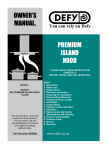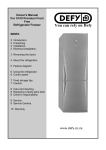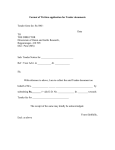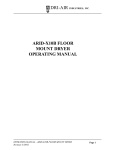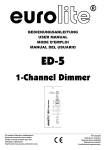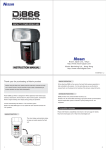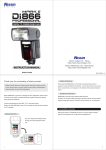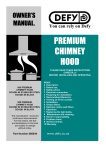Download Defy 900 C PREMIUM Owner`s manual
Transcript
OWNER’S MANUAL. You can rely on Defy 900 C PREMIUM EXTRACTOR HOOD PLEASE READ THESE INSTRUCTIONS CAREFULLY BEFORE INSTALLING AND OPERATING. DCH 253 900 C PREMIUM STAINLESS STEEL EXTRACTOR HOOD WITH CURVED GLASS. The manufacturer strives for continuous improvements. For this reason, the text and illustrations in this book are subject to change without notice. Part Number 066471. INDEX 2 Description. 2 Before use. 2 Safety advice. 2 Electrical connection. 3 Preparing for installation. 3 Re-circulating filtered air. 3 Venting air to the outside. 4 Installation. 5 Grease filter. 5 Optional Carbon pad filter. 6 Operation. 6 Replacing the light bulbs. 7 Maintenance and cleaning. 7 Owner’s responsibility. 8 Service. 8 Warranty. www.defy.co.za Page 1 • Description. • • • • • The extractor hood fan extracts the • • kitchen vapours and passes them through the grease filter. The grease filter absorbs the solid particles in the cooking vapours, keeping the kitchen almost free of grease. Before use. Electrical connection. Before using your new extractor hood for the first time, please read this manual carefully. It contains important information concerning your personal safety as well as on the use and care of the extractor hood. • Remove all packaging (except the protective film on the two chimney sections) and dispose of it in an environmentally friendly manner. • If the extractor hood is damaged in any way, do not use it. Report the damage to your dealer, who will take the necessary corrective action. (Refer to Owner’s responsibility on page 8 of this manual). • • • • Safety advice. • • Never operate the extractor hood without a grease filter. Never leave cooking fat or oil unattended. Overheated fat or oil can easily catch fire. Do not flambé food directly under the extractor hood. The flames pose the risk of the grease filter catching fire. (see page 7 under maintenance and cleaning) Restrictions apply to the use of the extractor hood over a solid fuel or gas stove. (See Preparing for installation on page 3). Switch off the power at the mains in the event of a fault or when cleaning the extractor hood Do not touch any part of the light fittings while they are in use as they get very hot and could cause severe burns. This extractor hood complies with all relevant safety regulations. The extractor hood is not intended for use by young children or infirm persons without supervision. Page 2 • The extractor hood uses a 220250V/50Hz power supply. If the mains power cord is damaged, it must be replaced by a qualified electrician. The power cord is located in the chimney area. Should you require an installation with no visible wiring, a 15 amp earthed plug socket should be accessible either in the ceiling above the extractor hood or on the wall behind the chimney area. (A qualified electrician should provide this facility). The extractor hood must be earthed. The manufacturer and the seller do not accept responsibility for any damage due to incorrect electrical connection. This extractor may not be used with a battery inverter power supply. Preparing for installation. The extractor hood has the ability to either recirculate the filtered air back into the kitchen, or to vent the filtered air through an outside wall. Decide on which option best suits you before commencing with the installation. • The extractor hood is intended to be mounted onto a flat perpendicular kitchen wall capable of supporting the weight of the hood. (approximately 26 kg.) Tools required for installation: • An electric drill. • A 3.5 mm dia. steel drill bit. • 8mm and 5mm dia. masonry drill bits • A star screw driver (Posi bit 2). • A ratchet with a 10mm socket and a 100mm extension. • A tape measure, masking tape and a pencil. ITEM DESCRIPTION QUANTITY 8mm wall plug 6mm screw 5mm wall plug 5mm screw 2 6 Self tapping screw 10 Slotted washer 2 Re-circulating filtered air. The extractor hood filters out solid particles before the air is re-circulated, via the vents on the side of the upper chimney, into the kitchen. ceiling Re-circulating filtered air Care must be taken during installation not to obstruct these vents. No ducting is required for this type of installation. Venting air to the outside. When discharging the air into a ventilation shaft or directly through the wall into the open , please take note of the following: • Exhaust air from the extractor hood must not be directed into a flue or chimney which is used for exhausting the fumes or smoke from appliances burning gas or fuels. • Please ensure that regulations concerning the discharge of exhaust air have been fulfilled. (SABS IEC 60335-2-31). For optimum extractor hood efficiency use a short, smooth, round air exhaust pipe with as few bends as possible. A 150mm diameter exhaust pipe is recommended. Long box section, narrowed or bent pipes will hinder performance and increase noise levels. • Connecting a 150 mm diameter pipe: Mount the pipe directly onto the air outlet on the extractor hood. • Connecting a 125 mm or 100mm diameter pipe: Attach a reducing connector (available from a specialist retailer) to the air pipe and then attach to the exhaust-air duct. ceiling ceiling Exhaust air through a dedicted pipe not shared with a fuel burning appliance. Page 3 • For mounting the 3 chimney brack- Installation. • Carefully remove the extractor hood and • • • the components from the packaging. Remove the grease filter ( see page 5). Draw a fine vertical line on the wall from the rear-centre of the hob to the ceiling. Draw another line, horizontal this time, where the bottom edge of the hood should be. (A minimum distance between the hob and the hood of 750mm is recommended.) CEILING MOUNTING TEMPLATE CUT TEMPLATE ALONG LINE HOOD MOUNTING TEMPLATE VETICAL LINE FROM HOB CENTRE TO CEILING ets, drill 6 holes, 5mm diameter and 45mm deep into the wall as indicated on the mounting template. • For mounting the extractor hood, drill 2 holes, 8mm in diameter and 60mm deep as indicated on the mounting template. • Once all the holes have been drilled the templates must be removed. • To attach the chimney mounting brackets push the 5mm wall plugs through the bracket holes and then insert the plugs together with the brackets into the wall holes and fasten securely. • Push the larger wall plugs into the hood mounting holes ensuring that they are flush with the surface. • Partially screw two 6mm screws into the wall plugs leaving them to protrude about 10mm. HORIZONTAL LINE 750 10mm • • • • Take the template card and separate the ceiling mounting template from the hood mounting template by cutting along the indicated line. Using masking tape, stick the ceiling mounting template to the wall directly below the ceiling and centered on the vertical line. In a similar fashion stick the hood mounting template on the wall ensuring that the centre-lines line up with those drawn on the wall. Page 4 Lift and hang the extractor hood onto the two protruding screws through the keyhole slots provided at the top of the extractor hood frame. • Place slotted washers between the extractor hood frame and the protruding screw heads • Align the extractor hood ‘V’ notch with the vertical centre line and align the body of the hood with the horizontal line before tightening the two screws. • Before fitting the chimneys, connect the outlet ducting (if required) and insert the fitted plug into the wall socket. • Remove the protective film from the chimney ducting taking care not to damage the polished stainless steel surface. • Fit the upper chimney duct section (the one with slotted outlets) to the ceiling mounting bracket using the self tapping screws supplied. CEILING MOUNTING BRACKET Grease filter. • Remove the plastic outer protective lining on the grease filter before fitting to the extractor hood. • To fit the filter, engage the two lugs at the rear of the filter into the rectangular slots of the extractor hood frame, lift the filter and press the handle catch inwards . • Engage the filter and release the catch. • To remove the filter, for cleaning purposes, reverse the procedure described above. TOP CHIMNEY DUCT • The lower duct fits onto the extractor • • • • hood and overlaps the upper duct. Loosely attach the lower duct bottom flange to the hood by four self tapping screws. The four screw holes are accessed from the underside of the hood. Fit the lower duct to the lower mounting bracket and tighten the four self tapping screws on the inside of the extractor hood. Using a 3.5mm dia drill, and using the two top holes in the lower chimney duct as a guide, drill through the upper chimney duct. Secure both ducts to the centre chimney mounting bracket using the self tapping screws supplied. DRILL TWO 3.5mm DIA.HOLES AND INSERT TWO SELF TAPPING SCREWS Optional Carbon pad filter. • Installations featuring an outside duct do not require a carbon pad filter. • Carbon pad filters assist in removing unwanted cooking odours from the atmosphere. • Should you require a carbon pad filter, a factory approved kit may be purchased from your nearest Defy Service Centre or their authorised agents. STEEL ROD REMOVED STEEL ROD IN PLACE CARBON PAD FILTER INSERT 4 SELF TAPPING SCREWS TO ATTACH THE LOWER CHIMNEY DUCT TO THE EXTRACTOR Page 5 GREASE FILTER Operation. • • • • • Select the fan speed you require. Push button 3 for high extraction level, 2 for medium and 1 for low. The fan indicator light will glow and the fan will operate at the selected setting. To switch off the fan, push the fan off button marked 0. If required, you may illuminate the cooking area by switching the hood lights on. Leave the hood running for a short period after the cooking has been completed to clear any smoke and odours. Fan off button 1 Lights on/ off 2 3 Fan speed 0 Fan indicator light Replacing the light bulbs. • • • • • • • • Switch off the electricity supply. If the bulb has recently failed, it might still be very hot. Allow the glass cover to cool before attempting to remove the bulb. Hold the glass cover and unclip the retaining ring by inserting a finger nail along the outer edge and pulling down. Be careful not to let the glass cover fall. Replace the light bulb with a commercially available OSRAM 12V 20W (64425) or equivalent bulb. Take care not to handle the replacement bulb with bare fingers as tranfered skin oil may shorten the life expectancy of the halogen bulb. Fit the glass cover in the retaining ring, align the 3 clips to the slots and clip back into place. Switch on the electricity supply. Page 6 Housing Glass cover Light bulb Retaining ring Maintenance and cleaning. Important: Before cleaning any part of the hood, switch the power off at the mains. Cleaning the metal grease filters. • In normal operation (1 to 2 hours daily), the metal grease filters must be cleaned every 8 to 10 weeks. • The filters may washed in a dishwasher, however they may discolour slightly. • When hand cleaning the filters, soak them in hot, soapy water to loosen the grease. • Brush with a stiff nylon brush. • Rinse clean and allow to air dry before re-fitting. • If cleaning is not carried out in accordance with the instructions, the accumulated grease could, over time, become a fire risk. General cleaning. Stainless steel is not adversely affected by normal household use but because of its reputation for durability, it is sometimes assumed to be indestructible, and therefore subjected to misuse or even abuse. Care should be taken to avoid such ‘abnormal use’. Cleaning materials. Do use: • A moist lint free soft cloth or synthetic sponge. • Soap, or mild liquid detergent. • A mild window cleaner. • Diluted ammonia in warm water. • A nylon bristle brush. • Cleaners labelled “Suitable for stainless steel”. Page 7 Do not use: • A steam cleaner. • Acid, alcohol, soda, chloride or spirit based cleaners. • Coarse abrasive cleaning powders. • Metallic scourers, steel wool, metal scrapers, or plastic scouring pads. • Wire brushes or emery paper. • So called “silver cleaners”. Cleaning procedure • Frequent cleaning is recommended rather than an occasional aggressive clean. • Routine cleaning will preserve the corrosion resistance and the appearance of the stainless steel for many years. • Clean the stainless steel as often as necessary (i.e. when it is noticeably dull or dirty) and use the simplest cleaning method that will effectively do the job. • Use clean water, or a mild detergent solution applied with a soft cloth or sponge. Rinse well and wipe dry. • Always wipe in the direction of the brushed texture on the stainless steel. • Periodically apply a fine film of dedicated stainless steel cleaner or baby oil to the canopy of the extractor hood to add lustre and sparkle to the steel. Owner’s responsibility. NOTE: Since the following are not factory faults, they are the owner’s responsibility. • Damage to exterior finish. • Breakage of glass and other components. • Replacement of the light bulbs. • Damage through improper use or installation. Service Before calling a service technician to assist with a problem…... See if a circuit breaker has tripped or a fuse has blown. Check the wall socket. Has the filter been cleaned? Is the chimney blocked? You may be charged for a service call even during the warranty period if the fault is due to or caused by any of the above. If you have followed the instructions and still have a problem, consult your telephone directory for the nearest regional Defy Service Centre. They will advise on any aspect of the product, direct you to the nearest Service Agent or have it repaired by qualified technicians. Service Centres are located in Bloemfontein, Cape Town, Durban, East London, Johannesburg, Polokwane, Port Elizabeth and Pretoria. Other areas are serviced by over 200 authorised Service Agents. Further details may be obtained from our Web Site: www.defy.co.za Warranty. This certificate is issued by DEFY APPLIANCES LIMITED manufacturers of Defy and Ocean products, hereinafter the Company, to the original purchaser only, of the appliance described on the certificate and shall constitute the only warranty given in respect of this appliance. The Company warrants to the original purchaser that for a period of TWO YEARS from date of purchase the appliance is free from defect under normal domestic use, both in workmanship and material, subject to the following conditions. 1. Repair or replacement of any part of this appliance, found by the Company to be defective, shall be at the election of the Company. The Company reserves the right to effect such service through any of its Service Divisions or Authorised Service Dealers. The cost of such service shall be borne by the Company in full, provided that the appliance is located no further than 50 km from a Company Service Centre or an Authorised Service Dealer. Where the appliance is located beyond the 50 km radius, the purchaser shall be liable for the standard travelling charges, as determined by the Company. CARRY IN SERVICE Microwave ovens, Compact cookers and small appliances are repaired in our service centres and are not collected from the customers home. Faulty units should be delivered to the purchasing dealer or to the nearest Company Service Centre for warranty repairs. 2. Rusted or corroded plates, vitreous enamelware, fuses and lamps are specifically excluded from these warranties. It is an express condition of these warranties that the purchaser takes due care and attention in the use and maintenance of the appliance. Abuse, misuse in conflict with operating instructions, connection to incorrect voltages and subjection to commercial use shall release the Company from its obligations. 3. This warranty shall become void and cease to operate if the appliance is dismantled by, or any repairs to the appliance are effected by any persons not duly authorised by the Company, or if substitute parts not approved by the Company are used in the appliance, or if the serial number of the appliance is removed. 4. The Company shall not be responsible for damages resulting from fire, flood, civil disturbances or any Act of God. The Company shall not, in terms of these warranties be responsible nor held liable for any consequential loss or damage of any kind caused by or due to the failure or malfunction of the appliance. 5. The Company shall not be responsible for transportation or other costs other than those incurred within the provisions of Point 1 of this Certificate. 6. These warranties shall not apply to the appliance if it is purchased or used beyond the borders of the Republic of South Africa, Namibia, Botswana, Swaziland and Lesotho. 7. Where service is requested under warranty and no fault or defect can be found by the Company, all costs incurred will be for the purchaser's account. 8. This Certificate as well as your invoice will serve as proof of purchase. For the purpose of warranty, it will be essential to produce this Certificate and invoice. Failure to do so, will render the purchaser liable for service costs. KEEP THIS CERTIFICATE AND SALES INVOICE AS PROOF OF PURCHASE FOR WARRANTY PURPOSES. Page 8








